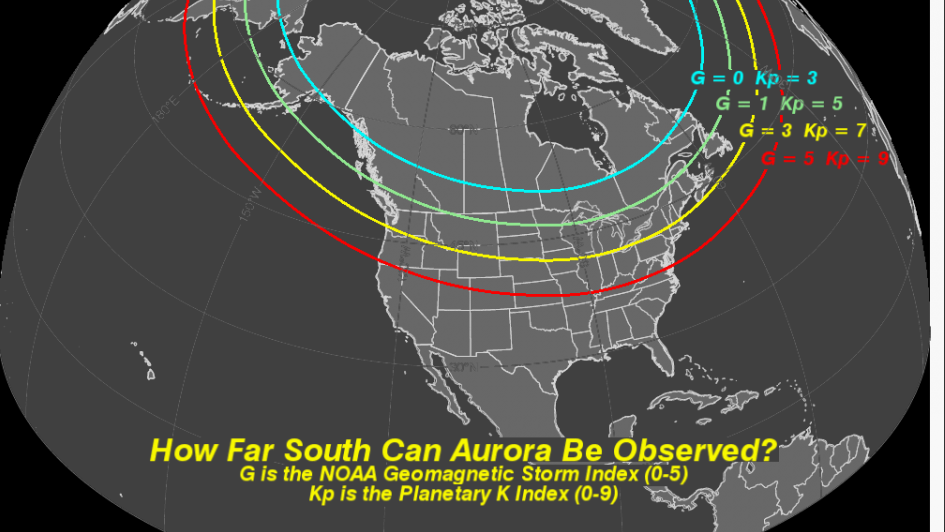Two celestial shows will be visible across Canada this week
Canada is getting not one – but two – celestial shows over the next few days.
The aurora borealis, also known as the northern lights, dazzled residents across a large stretch of North America on May 10.
Many people couldn’t help snapping pictures of the stunning light show in the sky.
PHOTO GALLERY: Aurora borealis as seen from southern Ontario
If you missed out on the northern lights, you’ll get a second chance on Friday night.
The aurora borealis will be visible across parts of Ontario, though a little more subdued this time around.
The U.S.-based National Oceanic and Atmospheric Administration (NOAA) rates geomagnetic storms from G1, or minor, or G5, extreme. The May 10 event was classified as a G4, while the Friday’s show is expected to be a G2.
 A Kp index of 6 or higher has sometimes allowed for glimpses of the aurora in the Maritimes. (Source: CTV News Atlantic)
A Kp index of 6 or higher has sometimes allowed for glimpses of the aurora in the Maritimes. (Source: CTV News Atlantic)
The lights will be visible across Canada and the northern U.S. states.
According to CTV Kitchener Weather Specialist Will Aiello, the clouds won’t get in the way.
“It’s looking like clear skies across the southwest, which is excellent news for anyone interested in seeing the stunning aurora borealis,” he said. “Doesn’t look like there will be a cloud in sight, so get those eyes to the sky!”
Parade of planets
Planet-watchers are in for another special treat.
As many as six planets will be lined up and visible in the night sky during the first week of June – Jupiter, Mars, Mercury, Neptune, Saturn and Uranus.
“Most of the time, these planets are all in different directions from the Earth, so we can only see a few of them at once,” Dr. Roan Haggar, a postdoctoral fellow at the University of Waterloo’s Centre for Astrophysics, said in a media release. “Occasionally though, several of them happen to be on the same side of the sun at the same time, meaning that from here on Earth, they all appear to be in the same direction.”
He added that planetary alignment happens quite often, but having all five together is an astronomical rarity.
While the planets will be visible every day for about a week, Haggar said the best day to see them is just before dawn on June 3.
“Neptune, Mars and Saturn will be visible in the east for a few hours before sunrise, but Jupiter, Mercury and Uranus will only rise about 30 minutes before the sun, so they might be hard to spot. You’ll need a telescope or a good pair of binoculars to see Neptune and Uranus, but the others will be visible if you’re somewhere with dark, clear skies,” the release explained.
As for the next planetary parade, seven will be visible at once in February 2025.
CTVNews.ca Top Stories

Poilievre writes to GG calling for House recall, confidence vote after Singh declares he's ready to bring Liberals down
Conservative Leader Pierre Poilievre has written to Gov. Gen. Mary Simon, imploring her to 'use your authority to inform the prime minister that he must' recall the House of Commons so a non-confidence vote can be held. This move comes in light of NDP Leader Jagmeet Singh publishing a letter stating his caucus 'will vote to bring this government down' sometime in 2025.
BREAKING At least 2 dead and 60 hurt after a car drives into a German Christmas market in a suspected attack
A car plowed into a busy outdoor Christmas market in the eastern German city of Magdeburg on Friday, killing at least two people and injuring at least 60 others in what authorities suspect was an attack.
Judge sentences Quebecer convicted of triple murder who shows 'no remorse'
A Quebecer convicted in a triple murder on Montreal's South Shore has been sentenced to life in prison without chance of parole for 20 years in the second-degree death of Synthia Bussieres.
'I understand there's going to be a short runway,' new minister says after Trudeau shuffles cabinet
Prime Minister Justin Trudeau added eight Liberal MPs to his front bench and reassigned four ministers in a cabinet shuffle in Ottawa on Friday, but as soon as they were sworn-in, they faced questions about the political future of their government, and their leader.
Fake nurse Brigitte Cleroux sentenced for B.C. crimes
A woman who impersonated nurses in several provinces has been sentenced to seven years in prison for offences in British Columbia – where she illegally treated nearly 1,000 patients across multiple communities.
Poilievre to Trump: 'Canada will never be the 51st state'
Conservative leader Pierre Poilievre is responding to U.S. president-elect Donald Trump’s ongoing suggestions that Canada become the 51st state, saying it will 'never happen.'
Toronto officials warn of possible measles exposure at Pearson airport
Toronto Public Health (TPH) is advising of another possible measles exposure at Canada’s largest airport.
Bail denied for Winnipeg woman accused of killing animals in online videos
Warning: This story contains disturbing details. Discretion is advised. A Winnipeg woman accused of making videos of animals being tortured and killed that were sold on the dark web was denied bail.
Party City closing in U.S., Canadian stores remain 'open for business'
The impending closure of all Party City locations in the United States will not extend into Canada.
































